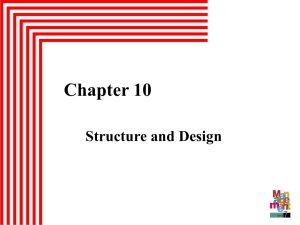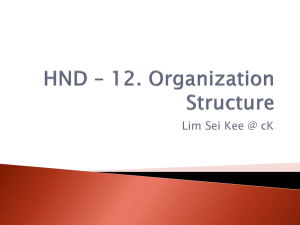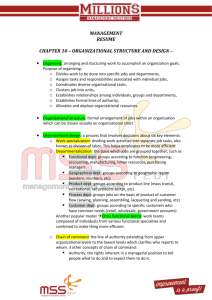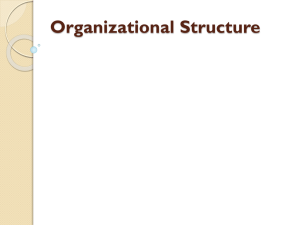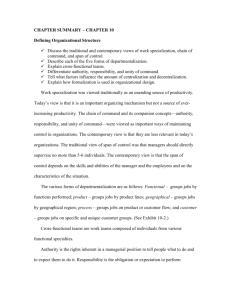File
advertisement
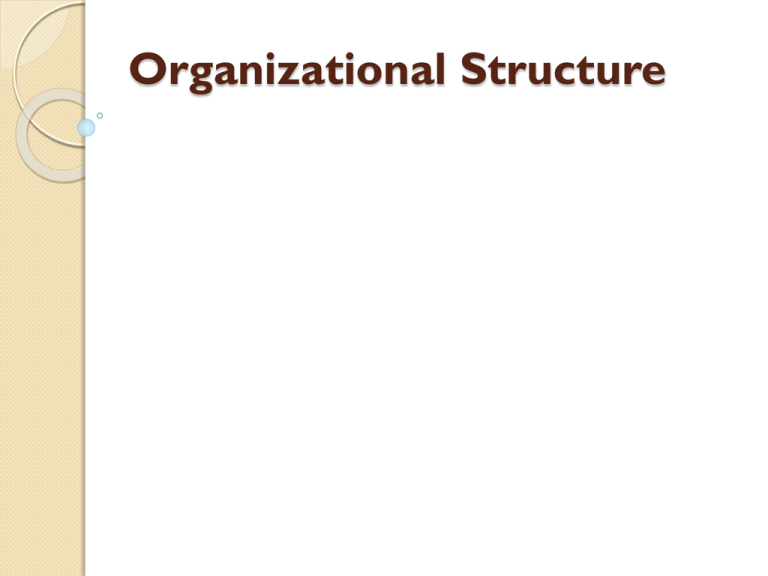
Organizational Structure LEARNING OBJECTIVES Explain the roles of formalization, centralization, levels in the hierarchy, and departmentalization in employee attitudes and behaviors. Describe how the elements of organizational structure can be combined to create mechanistic and organic structures. Understand the advantages and disadvantages of mechanistic and organic structures for organizations Definition How individual and team work within an organization are coordinated. Organizations can function within a number of different structures, each possessing distinct advantages and disadvantages Building Blocks of Structure 1. 2. 3. 4. Four aspects of structure that have been frequently studied in the literature: Centralization Formalization Hierarchical levels Departmentalization Centralization Centralization is the degree to which decision-making authority is concentrated at higher levels in an organization In centralized companies, many important decisions are made at higher levels of the hierarchy, whereas in decentralized companies, decisions are made and problems are solved at lower levels by employees who are closer to the problem in question Decentralized companies give more authority to lower-level employees, resulting in a sense of empowerment Many companies find that the centralization of operations leads to inefficiencies in decision making Hitting the right balance between decentralization and centralization is a challenge for many organizations Formalization Formalization is the extent to which an organization’s policies, procedures, job descriptions, and rules are written and explicitly articulated An advantage of formalization is that it makes employee behavior more predictable ; this leads to consistency of behavior A high degree of formalization may actually lead to: 1. Reduced innovativeness because employees are used to behaving in a certain manner 2. Reduced motivation and job satisfaction 3. Slower pace of decision making Hierarchical Levels Keeping the size of the organization constant, tall structures have several layers of management between frontline employees and the top level, while flat structures consist of only a few layers In tall structures, the number of employees reporting to each manager tends to be smaller, resulting in greater opportunities for managers to supervise and monitor employee activities. In contrast, flat structures involve a larger number of employees reporting to each manager leading to greater levels of freedom of action for each employee. In flat structures Employees experience greater levels of role ambiguity Advancement opportunities will be more limited because there are fewer management layers Provide greater need satisfaction for employees and greater levels of self actualization In tall structures employees feel a greater sense of job security Departmentalization Organizational structures differ in terms of departmentalization,( functional or divisional). Functional structures Organizations using functional structures ,group jobs based on similarity in functions Such structures may have departments such as marketing, manufacturing, finance, accounting, human resources, and information technology. In these structures, each person serves a specialized role and handles large volumes of transactions Divisional structures In organizations using divisional structures, departments represent the unique products, services, customers, or geographic locations the company is serving Each unique product or service the company is producing will have its own department. Within each department, functions such as marketing, manufacturing, and other roles are replicated Employees will be in charge of performing many different tasks in the service of the product Functional structures tend to be effective when an organization does not have a large number of products and services requiring special attention Functional structures are more effective in stable environments that are slower to change. Pharmaceutical Company with a Functional Departmentalization Structure Pharmaceutical Company with a Divisional Departmentalization Structure Two Configurations: Mechanistic and Organic Structures Mechanistic structures are those that resemble a bureaucracy. These structures are highly formalized and centralized. communication tends to follow formal channels and employees are given specific job descriptions delineating their roles and responsibilities Mechanistic organizations are often rigid and resist change, making them unsuitable for innovativeness and taking quick action The main advantage of a mechanistic structure is its efficiency The presence of a mechanistic structure has been shown to be related to firm performance in new ventures Organic structures are flexible and decentralized, with low levels of formalization communication lines are more fluid and flexible Employee job descriptions are broader Employees are asked to perform duties based on the specific needs of the organization at the time as well as their own expertise levels Higher levels of job satisfaction on the part of employees EXERCISES What are the advantages and disadvantages of decentralization? All else being equal, would you prefer to work in a tall or flat organization? Why? What are the advantages and disadvantages of departmentalization by product? would you work in a Mechanistic organizations Mechanistic organization? Why? /why not?
